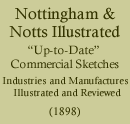< Previous | Contents | Next >
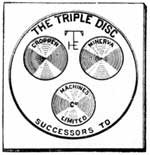
Messrs. H. S. CROPPER & CO.,
Minerva Works, Great Alfred Street, NOTTINGHAM.
WITHIN the range of invaluable improvements in printing machinery recorded during the Victorian era, none have been of more importance in the book and jobbing trade than the introduction into this country of the platen machine, which may be said to have effected as remarkable a revolution in this branch as did the adoption of the Hoe in the newspaper press. To the Cropper-Minerva Machines Company, Limited, through their predecessors, the late H. S. Cropper and Co. (of which Mr. Samuel Thacker, now managing director of the company, is the only surviving partner), belongs the credit of placing on the English market a machine that has consistently gained a popularity since its introduction, as evidenced by the fact that over 20,000 of the "Croppers" are in use here and in America—one firm alone, Messrs. McCorquodale, having 67 machines, Messrs. Bemrose and Sons 10, Messrs. Couldrey and Co. 18, and Messrs. Shuttleworth and Bunn 17, of this type at work in their establishments.
The present firm are successors to the original H. S. Cropper and Co., whose business went into liquidation on the death of the senior partner, and was purchased as a going concern by Walter and H. R. Thacker, the sons of Mr. Samuel Thacker. Soon after this transaction, litigation was commenced against Messrs. Cropper, Charlton and Hole, who claimed the right to use the term "Cropper" as applied to their platen printing machines. Both parties were represented before Mr. Justice Romer, in the Chancery Division of the High Court, and, after a protracted hearing, his Lordship delivered judgment in favour of the plaintiff in the action—Mr. Thacker. As the firm are frequently receiving enquiries on this point, it may be appropriate to introduce at this stage of our notice the terms of Mr. Justice Romer's judgment. This is as follows:—"An injunction to restrain the defendants from carrying on their business under the name of the Cropper Machine Company, or under any name calculated to induce the belief that they are the successors in business of H. S. Cropper and Company, or of the Limited Company, or are entitled to sell platen machines not made by H. S. Cropper and Company, or by the Limited Company, or by the plaintiffs as Cropper machines. Then there will be an injunction restraining the defendants from further issuing the advertisements which have been exhibited, or any advertisements calculated to induce the belief that they are the successors in business of H. S. Cropper and Company, or of the Limited Company, or are entitled to sell platen machines not made by H. S. Cropper and Company, or by the Limited Company, or by the plaintiffs as Cropper machines." This judgment so clearly defines the position of the Cropper-Minerva Company that any doubt previously entertained on this point by the trade may be considered dispelled for all time.
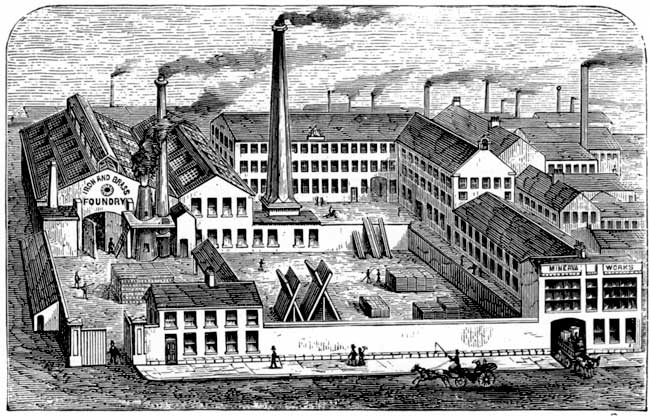
Minerva Works.
The company's premises, known as the Minerva Works, are situated in Alfred Street North, and are erected in a substantial manner, covering a considerable area in extent. The general and private offices, stores, and warehouse occupy a range of buildings extending from the main entrance to the principal workshops in the rear. These are contained in a three storey building 90 feet by 40 feet, the ground floor being occupied as the machine shop, with the erecting shop above. A most complete and extensive plant of machine tools and other appliances is installed in the various manufacturing departments, motive force being supplied by a steam engine and boiler erected on the premises. A large forge, fitted with blower and powerful steam hammer, divides the workshops from the foundry, a building some 60 feet by 50 feet, commanded by two cranes, while adjoining are two cupolas, furnished with Root's Patent Blowers for supplying the blast. The remainder of the premises include fitting and other minor shops, pattern shop and boiler shed, the latter located in the yard. The establishment, it will be recognised, is admirably equipped and organised in every detail of the arrangements, and provides facilities for each branch of manufacture, from the initial stage of dealing with the raw material to the completion of the finished machines, entirely independent of outside assistance.
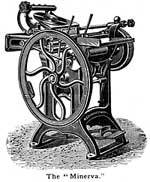
In presenting a brief outline of the principal features of the firm's specialities, we give, of course, priority of mention to the "Minerva," better known as the "Cropper" machine. The advantages combined in this make may be summarised as follows:—The impression is perfectly even, and being regulated by a single screw, can be thrown off instantly. Perfect register is secured, and slurring is impossible, the platen being secured by a locking apparatus. The distribution, by means of revolving discs, is unique and incapable of improvement. Rolling: a lateral movement is now given to the rollers, and by this improved system no part of the rollers can pass a second time over the forme in the same place. In addition to these points, the Cuthbertson Counter can be applied if required, the firm having taken out a patent for this appliance in March, 1897. One of the most recent improvements made in the "Minerva" is the construction of solid standards, which give strength and rigidity where most required. Another advantage obtained by purchasing this machine is that all the various parts of the "Cropper" frame and mechanism are kept in stock, enabling the customer to replace any portion damaged with the utmost promptitude, at very reasonable charges. The "Minerva" is also constructed with patent self flyer, an attachment of the utmost value in economising time and labour.
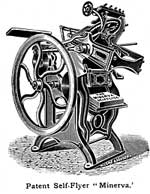
The 1896 "Improved Cropper," for which letters patent have been secured, retains all those advantages for which the "Cropper" has acquired so world-wide a reputation, and possesses the following additional advantages, namely:—The type bed and ink trough are cast in one solid piece, thus dispensing with the ink-duct arms and the complicated apparatus in connection with the ink-duct arrangement, so evident in all other platen machines. By our patented alteration the ink disc or slab is lengthened, therefore greater distance and time are obtained by an independent vibratory roller travelling the whole length of the ink disc, and, what is more important, three rollers pass clear over the fullest forme. It will thus be apparent that a much finer distribution takes place, and the forme is equally and evenly inked. Strength and rigidity are also noticeable features that have been studied successfully—in fact, a forme as full as the chase can hold may be worked without the slightest liability to cause over-straining, while the ease and speed of running is not at all impeded by the alterations described above. While this machine has been specially constructed to meet the requirements of artistic printers, it is at the same time the best machine for general business work. In introducing the "Improved Cropper," we trust that it may be the means of still further cementing and improving our position with the printing and kindred trades.
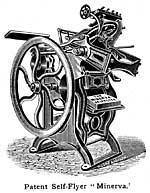
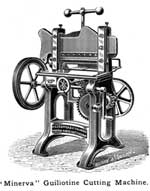
With the Patent Self-Flyer "Minerva," the sheets are fed in the usual manner, and after receiving the impression are seized by grippers. and piled (face uppermost) on the board at the back of the machine, as shown in the illustration. The advantages afforded by the self-flyer for long numbers, especially in the large-size machines, will be at once apparent, the operator having both hands at liberty for manipulating the sheet.
In the "Minerva" Guillotine Cutting Machine, the Company have introduced to the trade a speciality which, for strength and durability, has no rival, and the ease with which it does its work may be described as simply marvellous. This machine is very powerfully built, and the cog-wheels are cut perfectly true by specially-made machinery. There are no cams, consequently the knife proceeds with a steady descent through the hardest mill-board without the slighest jerk, and making no steps in the cut. It will take a cut of three-and-a-half inches deep. The front as well as the back tables are all of smoothly polished iron.
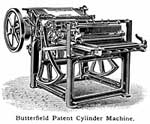
To meet the requirements of a numerous section of the trade, the Company have introduced in the Butterfield Patent Cylinder Machine an excellent improvement in this class of treadle or power printing press. This machine em-bodies an entirely new and improved principle to the ordinary cylinder presses, possessing few working parts, but claiming many advantages not found in other machines. The most salient features of the Butterfield machines are as follows:—The type bed is stationary, and the cylinder only rotates when taking the impression. The forme is clear of rollers, and can be seen by the operator after each sheet is printed. There is no lifting of rollers to get at the forme, and no sheets can get in the rollers. It is easy to make ready, as there is nothing in the way. The type cannot get knocked off its feet or damaged at the edges; no rising spaces or springing rules; consequently the type will last much longer than on any other machine. The type bed is adjustable by two hand screws, giving great nicety in regulating the impression whatever the height of the forme, and the cylinder remains firm on its bearings and deep in gear. The cylinder has a check stop motion, and the feeding table does not move when the cylinder is checked. The sheets are taken off without flyers, wood cylinder, tapes or reels to smear the work. The printed sheet is in view of the operator during and after the impression is taken, and the sheet is delivered by its take edge into the "retainer" and held out in full view. There is much more time for feeding than on any other machine, consequently it can be run at a high speed. The distribution and inking are the best extant. It is easy to work, and will print any job from a line of nonpareil to a heavy demy folio bill. The Company also undertake the manufacture of Swiss embroidery machines, and frilling and patent edging machines, in extensive demand in local iudustries. In the illustrated price lists issued by the firm, in addition to drawings of their celebrated specialities, are incorporated numerous testimonials, expressing the highest satisfaction on the part of purchasers of the "Cropper" machines, many of which emanate from the leading houses in the printing trade of Great Britain.
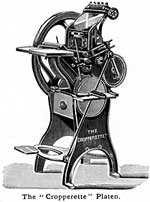
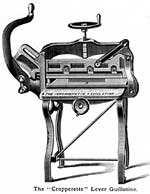
The "Cropperette" Platen is made in two sizes, No. 1 being 8in. by 5in. (inside chase), and No. 2, 11 in. by 7 inch(inside chase).
The "Cropperette" Lever Guillotine is made in three sizes, namely:— 12in. by 2in., 20in. by 3m., and 22in. by 3m.
The Company also undertake the complete furnishing and equipment of printing offices on any scale, either for the home trade or export; and yet another department of importance is the overhauling of machines. In connection with this branch, it may be added that the Company, having all the old patterns in stock, can replace all worn parts with new ones to any class of their own make of machine, and when re-painted they have the appearance and are in every respect as good as when originally new, in fact, better, by the application of their latest improvements. These include the extended disc, the improved ink duct, and if the machine be a loose standard one, the application of a bar at the feet, thus giving more rigidity to the machine than when it was new. As an evidence of their confidence in giving satisfaction, and as an inducement for machines to be sent for overhauling, they undertake to pay the carriage one way, make the most reasonable charge according to age and condition, and execute the order with all possible expedition.
